Factors Excluding Female Managers in Oil and Gas: Dissertation
VerifiedAdded on 2023/03/17
|52
|13631
|52
Thesis and Dissertation
AI Summary
This dissertation investigates the factors that exclude female managers from reaching senior management positions within the oil and gas industry. The research explores gender discrimination, recruitment policies, workplace disparities, and stereotypical thinking as key barriers. Employing a positivism philosophy, deductive approach, and descriptive design, the study utilizes interviews with five female managers to gather primary data. The findings reveal that female managers face significant challenges, including limited promotion opportunities and gender bias, despite their qualifications. The dissertation analyzes these factors, discusses the implications, and provides recommendations for promoting female inclusion and equal opportunities in the sector. The structure includes an introduction, literature review, methodology, data analysis, discussion, and conclusion, offering a comprehensive examination of the issue and potential solutions. The research highlights the importance of addressing gender roles, bias, and confidence to foster a more inclusive and equitable work environment.
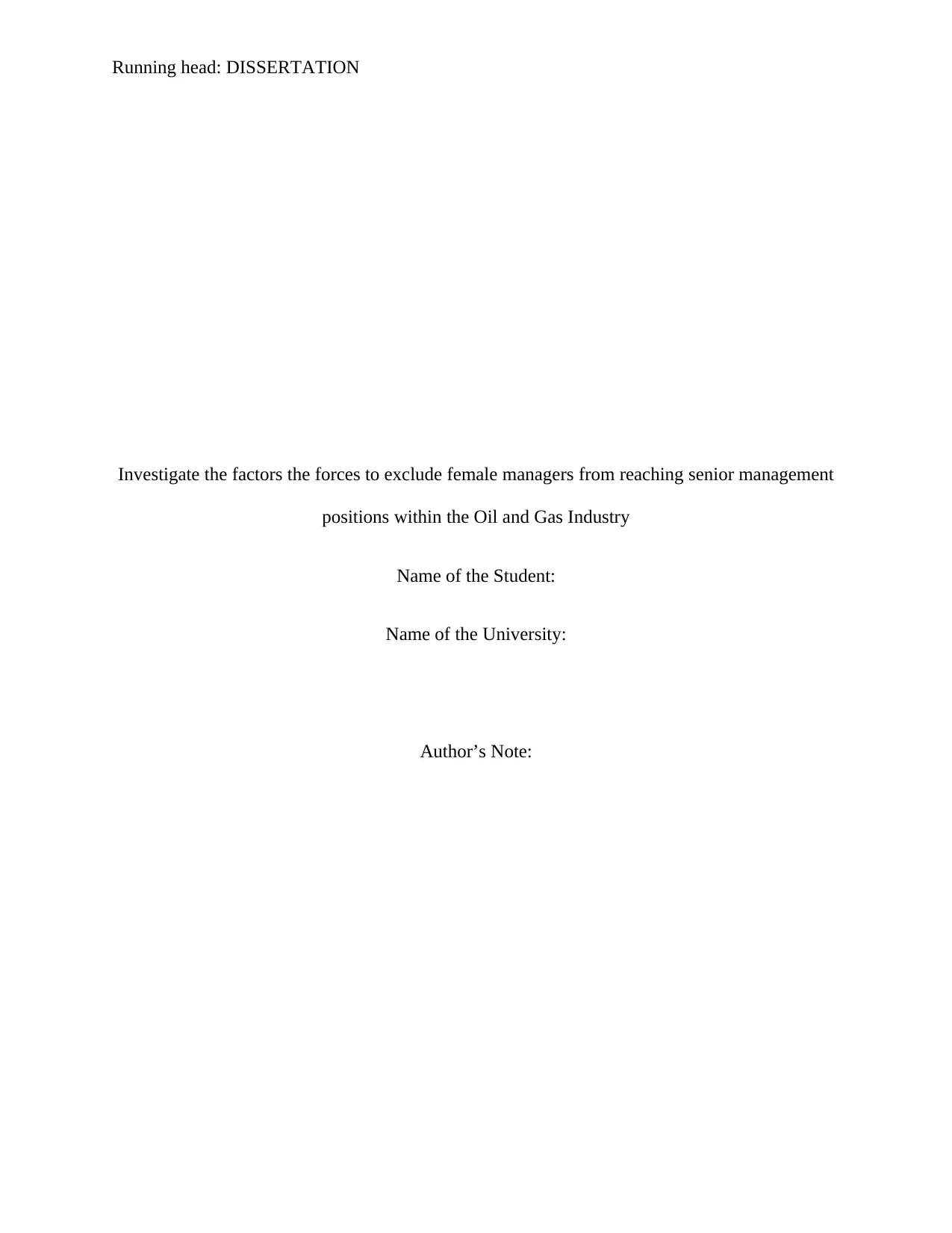
Running head: DISSERTATION
Investigate the factors the forces to exclude female managers from reaching senior management
positions within the Oil and Gas Industry
Name of the Student:
Name of the University:
Author’s Note:
Investigate the factors the forces to exclude female managers from reaching senior management
positions within the Oil and Gas Industry
Name of the Student:
Name of the University:
Author’s Note:
Paraphrase This Document
Need a fresh take? Get an instant paraphrase of this document with our AI Paraphraser
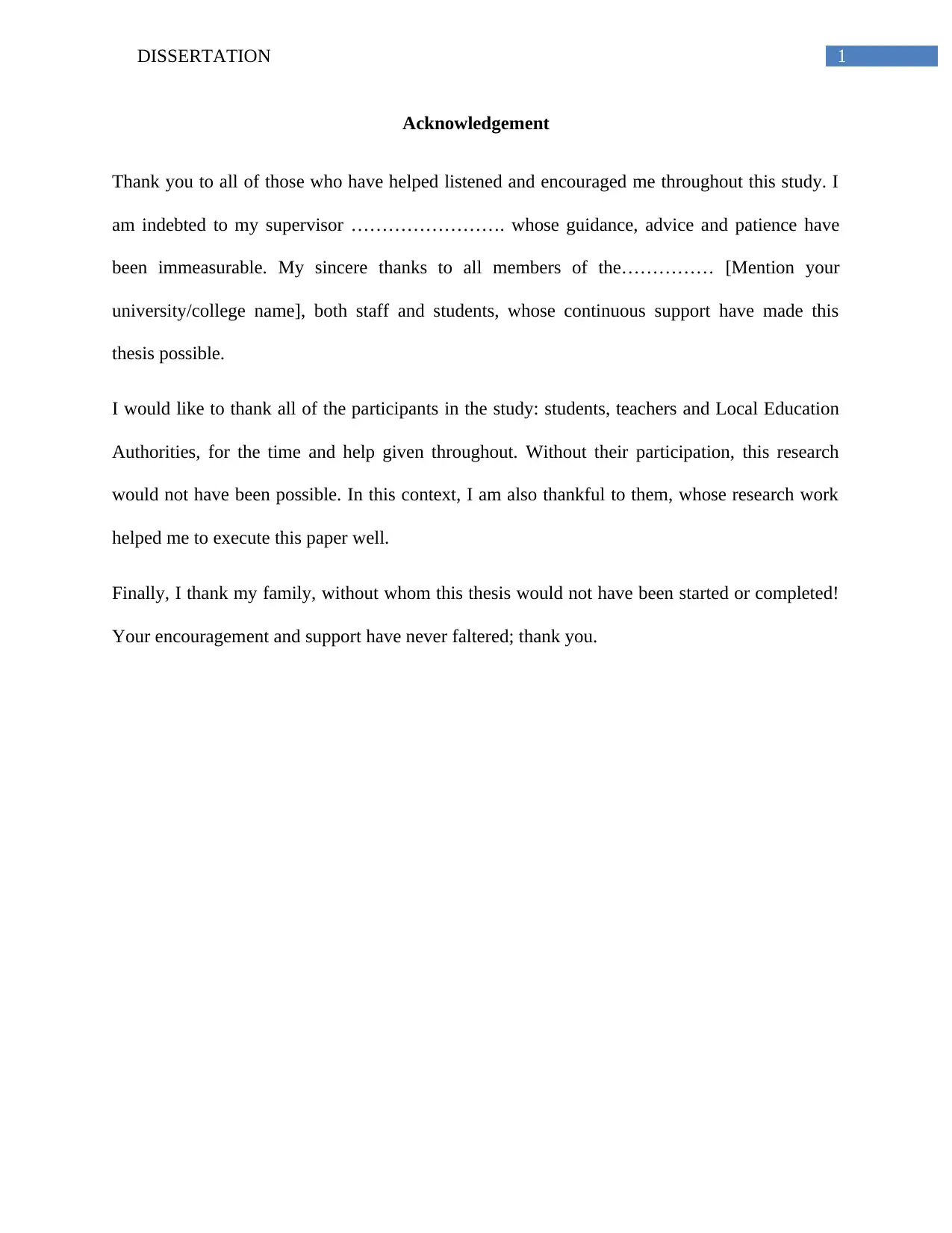
1DISSERTATION
Acknowledgement
Thank you to all of those who have helped listened and encouraged me throughout this study. I
am indebted to my supervisor ……………………. whose guidance, advice and patience have
been immeasurable. My sincere thanks to all members of the…………… [Mention your
university/college name], both staff and students, whose continuous support have made this
thesis possible.
I would like to thank all of the participants in the study: students, teachers and Local Education
Authorities, for the time and help given throughout. Without their participation, this research
would not have been possible. In this context, I am also thankful to them, whose research work
helped me to execute this paper well.
Finally, I thank my family, without whom this thesis would not have been started or completed!
Your encouragement and support have never faltered; thank you.
Acknowledgement
Thank you to all of those who have helped listened and encouraged me throughout this study. I
am indebted to my supervisor ……………………. whose guidance, advice and patience have
been immeasurable. My sincere thanks to all members of the…………… [Mention your
university/college name], both staff and students, whose continuous support have made this
thesis possible.
I would like to thank all of the participants in the study: students, teachers and Local Education
Authorities, for the time and help given throughout. Without their participation, this research
would not have been possible. In this context, I am also thankful to them, whose research work
helped me to execute this paper well.
Finally, I thank my family, without whom this thesis would not have been started or completed!
Your encouragement and support have never faltered; thank you.
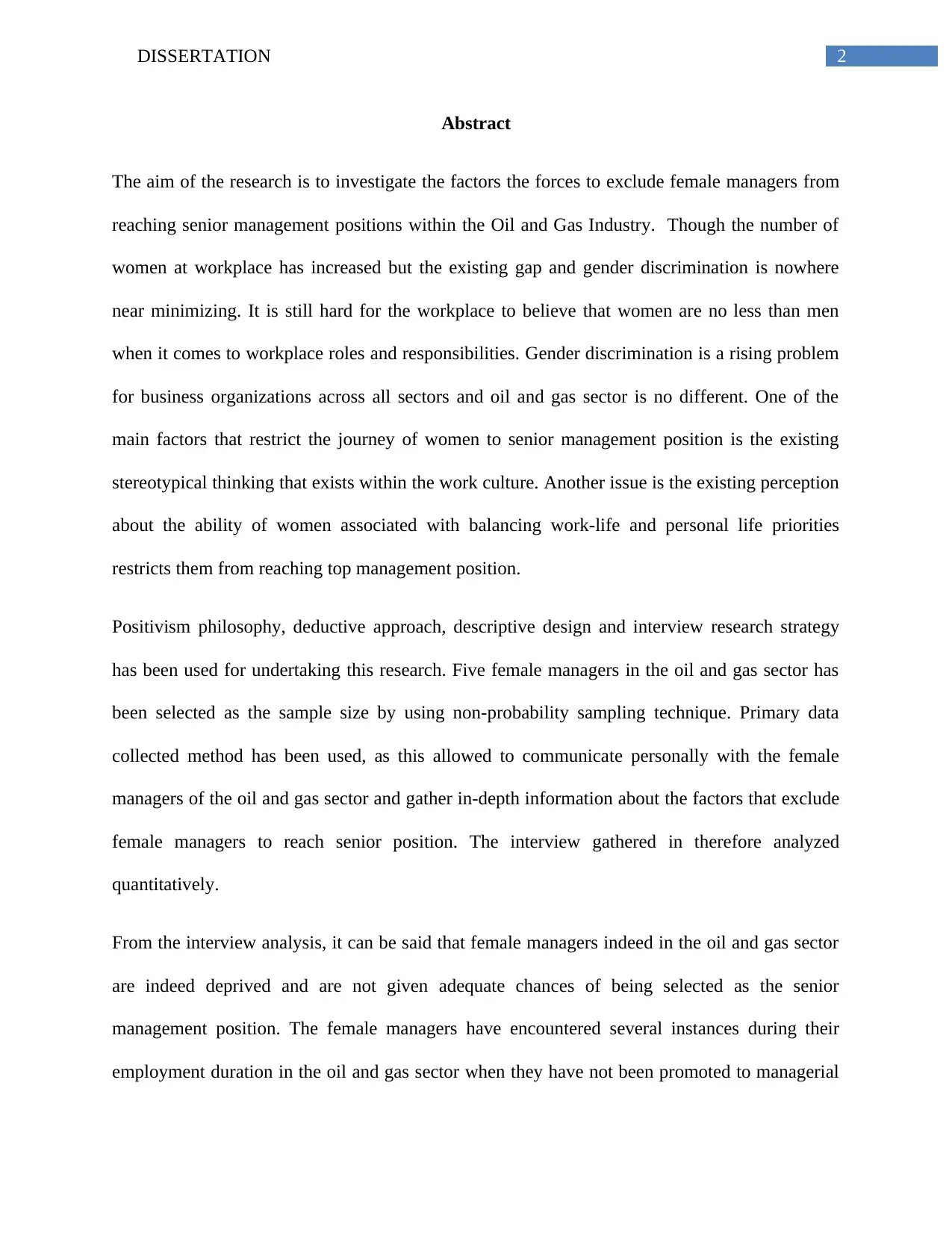
2DISSERTATION
Abstract
The aim of the research is to investigate the factors the forces to exclude female managers from
reaching senior management positions within the Oil and Gas Industry. Though the number of
women at workplace has increased but the existing gap and gender discrimination is nowhere
near minimizing. It is still hard for the workplace to believe that women are no less than men
when it comes to workplace roles and responsibilities. Gender discrimination is a rising problem
for business organizations across all sectors and oil and gas sector is no different. One of the
main factors that restrict the journey of women to senior management position is the existing
stereotypical thinking that exists within the work culture. Another issue is the existing perception
about the ability of women associated with balancing work-life and personal life priorities
restricts them from reaching top management position.
Positivism philosophy, deductive approach, descriptive design and interview research strategy
has been used for undertaking this research. Five female managers in the oil and gas sector has
been selected as the sample size by using non-probability sampling technique. Primary data
collected method has been used, as this allowed to communicate personally with the female
managers of the oil and gas sector and gather in-depth information about the factors that exclude
female managers to reach senior position. The interview gathered in therefore analyzed
quantitatively.
From the interview analysis, it can be said that female managers indeed in the oil and gas sector
are indeed deprived and are not given adequate chances of being selected as the senior
management position. The female managers have encountered several instances during their
employment duration in the oil and gas sector when they have not been promoted to managerial
Abstract
The aim of the research is to investigate the factors the forces to exclude female managers from
reaching senior management positions within the Oil and Gas Industry. Though the number of
women at workplace has increased but the existing gap and gender discrimination is nowhere
near minimizing. It is still hard for the workplace to believe that women are no less than men
when it comes to workplace roles and responsibilities. Gender discrimination is a rising problem
for business organizations across all sectors and oil and gas sector is no different. One of the
main factors that restrict the journey of women to senior management position is the existing
stereotypical thinking that exists within the work culture. Another issue is the existing perception
about the ability of women associated with balancing work-life and personal life priorities
restricts them from reaching top management position.
Positivism philosophy, deductive approach, descriptive design and interview research strategy
has been used for undertaking this research. Five female managers in the oil and gas sector has
been selected as the sample size by using non-probability sampling technique. Primary data
collected method has been used, as this allowed to communicate personally with the female
managers of the oil and gas sector and gather in-depth information about the factors that exclude
female managers to reach senior position. The interview gathered in therefore analyzed
quantitatively.
From the interview analysis, it can be said that female managers indeed in the oil and gas sector
are indeed deprived and are not given adequate chances of being selected as the senior
management position. The female managers have encountered several instances during their
employment duration in the oil and gas sector when they have not been promoted to managerial
⊘ This is a preview!⊘
Do you want full access?
Subscribe today to unlock all pages.

Trusted by 1+ million students worldwide
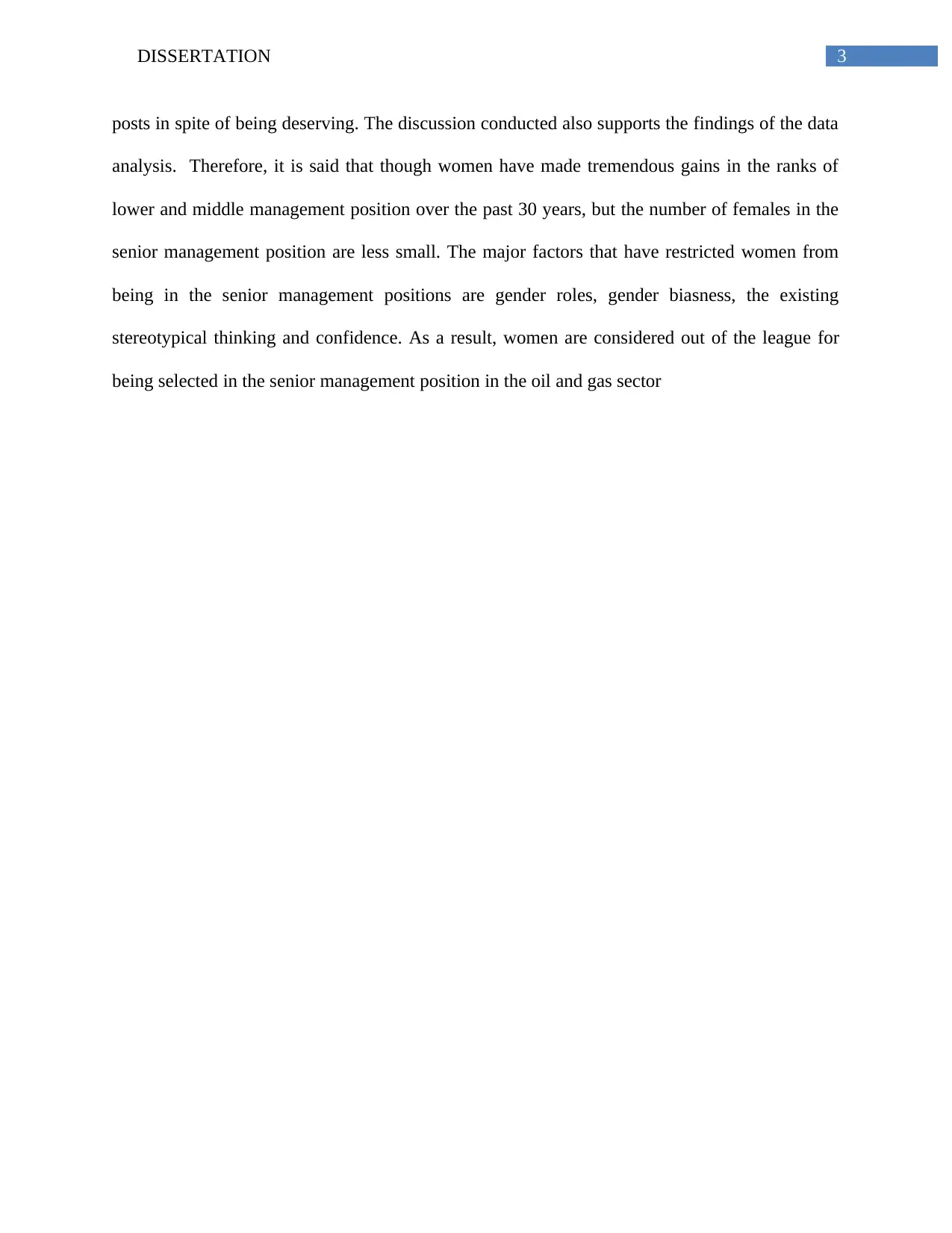
3DISSERTATION
posts in spite of being deserving. The discussion conducted also supports the findings of the data
analysis. Therefore, it is said that though women have made tremendous gains in the ranks of
lower and middle management position over the past 30 years, but the number of females in the
senior management position are less small. The major factors that have restricted women from
being in the senior management positions are gender roles, gender biasness, the existing
stereotypical thinking and confidence. As a result, women are considered out of the league for
being selected in the senior management position in the oil and gas sector
posts in spite of being deserving. The discussion conducted also supports the findings of the data
analysis. Therefore, it is said that though women have made tremendous gains in the ranks of
lower and middle management position over the past 30 years, but the number of females in the
senior management position are less small. The major factors that have restricted women from
being in the senior management positions are gender roles, gender biasness, the existing
stereotypical thinking and confidence. As a result, women are considered out of the league for
being selected in the senior management position in the oil and gas sector
Paraphrase This Document
Need a fresh take? Get an instant paraphrase of this document with our AI Paraphraser
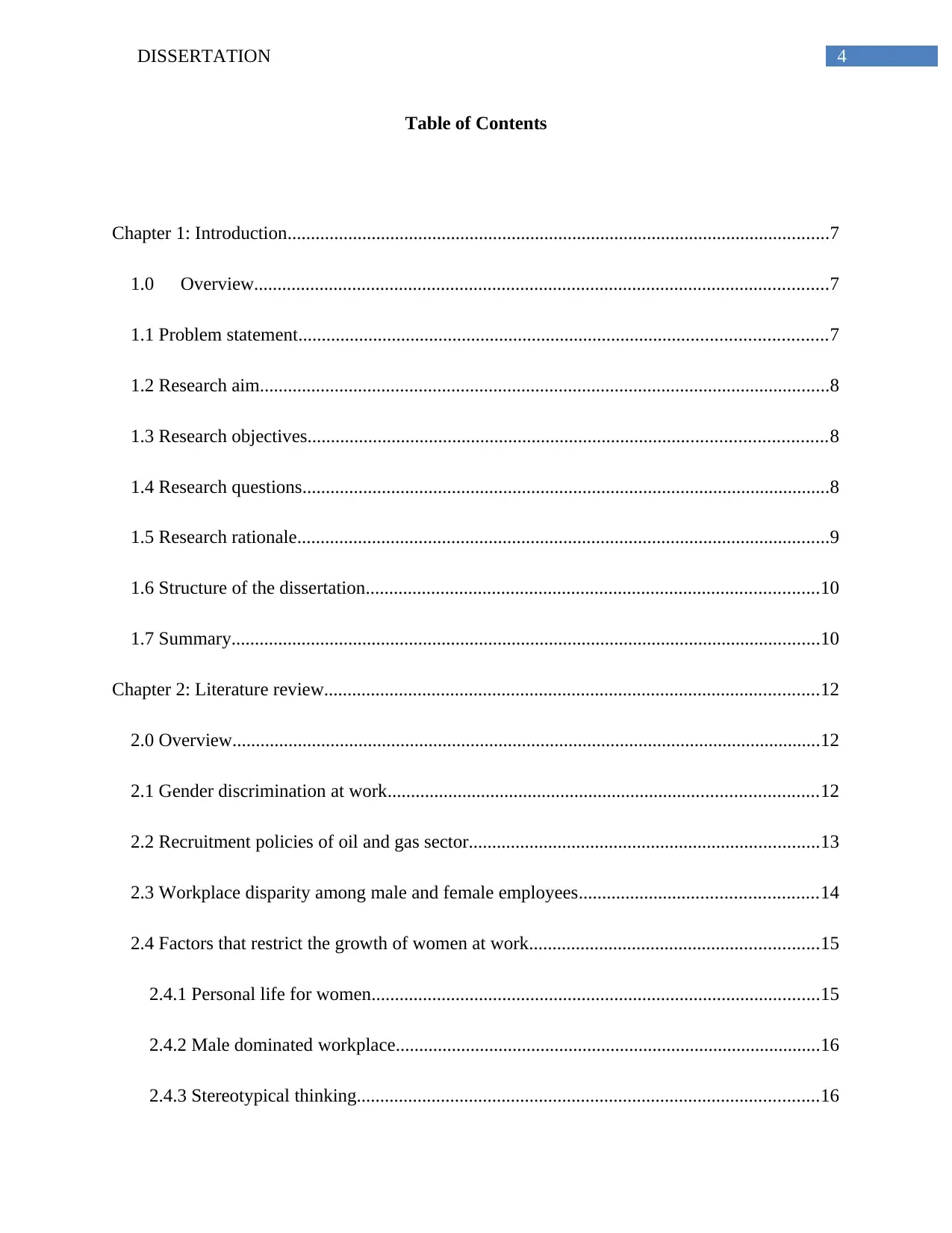
4DISSERTATION
Table of Contents
Chapter 1: Introduction....................................................................................................................7
1.0 Overview...........................................................................................................................7
1.1 Problem statement.................................................................................................................7
1.2 Research aim..........................................................................................................................8
1.3 Research objectives...............................................................................................................8
1.4 Research questions.................................................................................................................8
1.5 Research rationale..................................................................................................................9
1.6 Structure of the dissertation.................................................................................................10
1.7 Summary..............................................................................................................................10
Chapter 2: Literature review..........................................................................................................12
2.0 Overview..............................................................................................................................12
2.1 Gender discrimination at work............................................................................................12
2.2 Recruitment policies of oil and gas sector...........................................................................13
2.3 Workplace disparity among male and female employees...................................................14
2.4 Factors that restrict the growth of women at work..............................................................15
2.4.1 Personal life for women................................................................................................15
2.4.2 Male dominated workplace...........................................................................................16
2.4.3 Stereotypical thinking...................................................................................................16
Table of Contents
Chapter 1: Introduction....................................................................................................................7
1.0 Overview...........................................................................................................................7
1.1 Problem statement.................................................................................................................7
1.2 Research aim..........................................................................................................................8
1.3 Research objectives...............................................................................................................8
1.4 Research questions.................................................................................................................8
1.5 Research rationale..................................................................................................................9
1.6 Structure of the dissertation.................................................................................................10
1.7 Summary..............................................................................................................................10
Chapter 2: Literature review..........................................................................................................12
2.0 Overview..............................................................................................................................12
2.1 Gender discrimination at work............................................................................................12
2.2 Recruitment policies of oil and gas sector...........................................................................13
2.3 Workplace disparity among male and female employees...................................................14
2.4 Factors that restrict the growth of women at work..............................................................15
2.4.1 Personal life for women................................................................................................15
2.4.2 Male dominated workplace...........................................................................................16
2.4.3 Stereotypical thinking...................................................................................................16
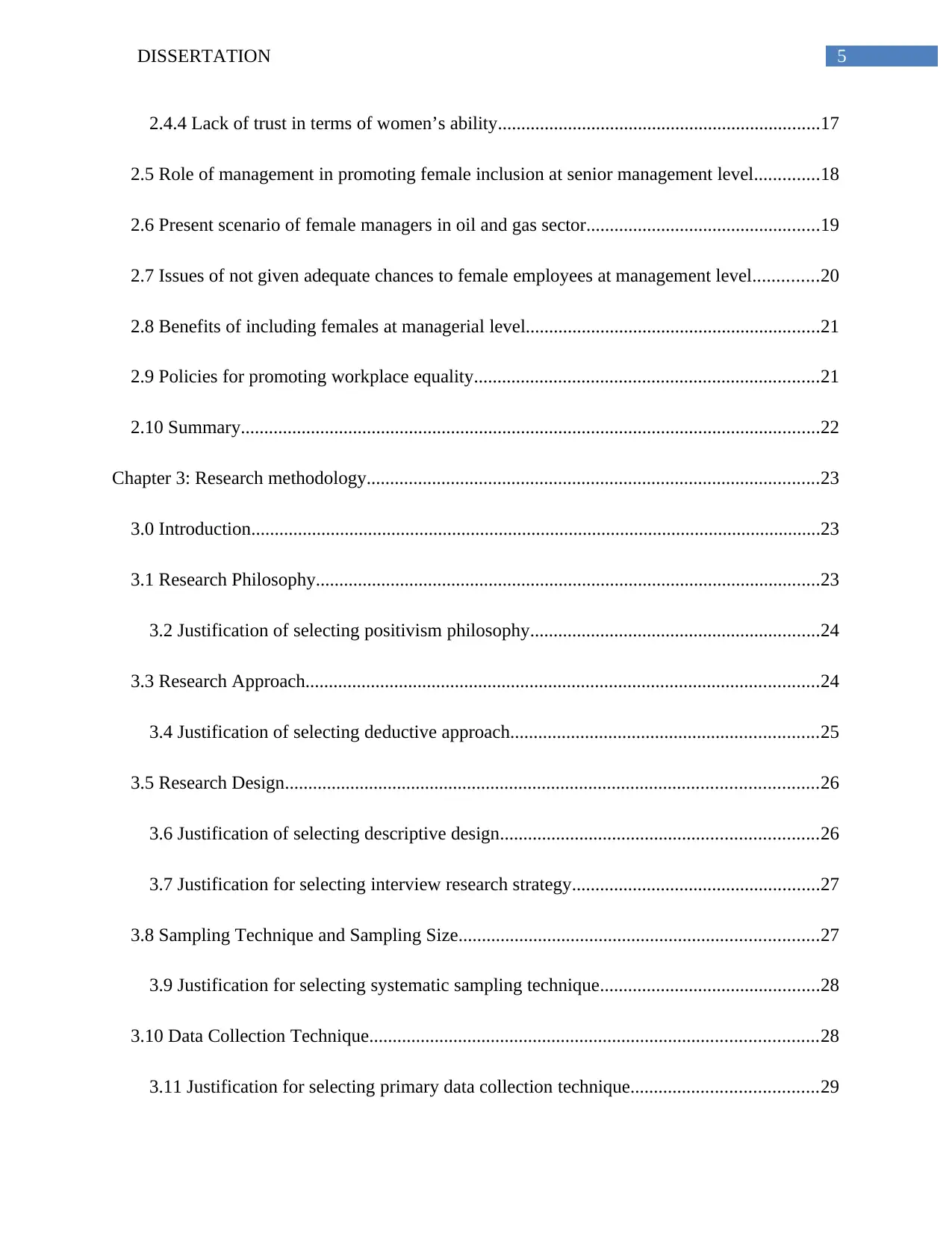
5DISSERTATION
2.4.4 Lack of trust in terms of women’s ability.....................................................................17
2.5 Role of management in promoting female inclusion at senior management level..............18
2.6 Present scenario of female managers in oil and gas sector..................................................19
2.7 Issues of not given adequate chances to female employees at management level..............20
2.8 Benefits of including females at managerial level...............................................................21
2.9 Policies for promoting workplace equality..........................................................................21
2.10 Summary............................................................................................................................22
Chapter 3: Research methodology.................................................................................................23
3.0 Introduction..........................................................................................................................23
3.1 Research Philosophy............................................................................................................23
3.2 Justification of selecting positivism philosophy..............................................................24
3.3 Research Approach..............................................................................................................24
3.4 Justification of selecting deductive approach..................................................................25
3.5 Research Design..................................................................................................................26
3.6 Justification of selecting descriptive design....................................................................26
3.7 Justification for selecting interview research strategy.....................................................27
3.8 Sampling Technique and Sampling Size.............................................................................27
3.9 Justification for selecting systematic sampling technique...............................................28
3.10 Data Collection Technique................................................................................................28
3.11 Justification for selecting primary data collection technique........................................29
2.4.4 Lack of trust in terms of women’s ability.....................................................................17
2.5 Role of management in promoting female inclusion at senior management level..............18
2.6 Present scenario of female managers in oil and gas sector..................................................19
2.7 Issues of not given adequate chances to female employees at management level..............20
2.8 Benefits of including females at managerial level...............................................................21
2.9 Policies for promoting workplace equality..........................................................................21
2.10 Summary............................................................................................................................22
Chapter 3: Research methodology.................................................................................................23
3.0 Introduction..........................................................................................................................23
3.1 Research Philosophy............................................................................................................23
3.2 Justification of selecting positivism philosophy..............................................................24
3.3 Research Approach..............................................................................................................24
3.4 Justification of selecting deductive approach..................................................................25
3.5 Research Design..................................................................................................................26
3.6 Justification of selecting descriptive design....................................................................26
3.7 Justification for selecting interview research strategy.....................................................27
3.8 Sampling Technique and Sampling Size.............................................................................27
3.9 Justification for selecting systematic sampling technique...............................................28
3.10 Data Collection Technique................................................................................................28
3.11 Justification for selecting primary data collection technique........................................29
⊘ This is a preview!⊘
Do you want full access?
Subscribe today to unlock all pages.

Trusted by 1+ million students worldwide
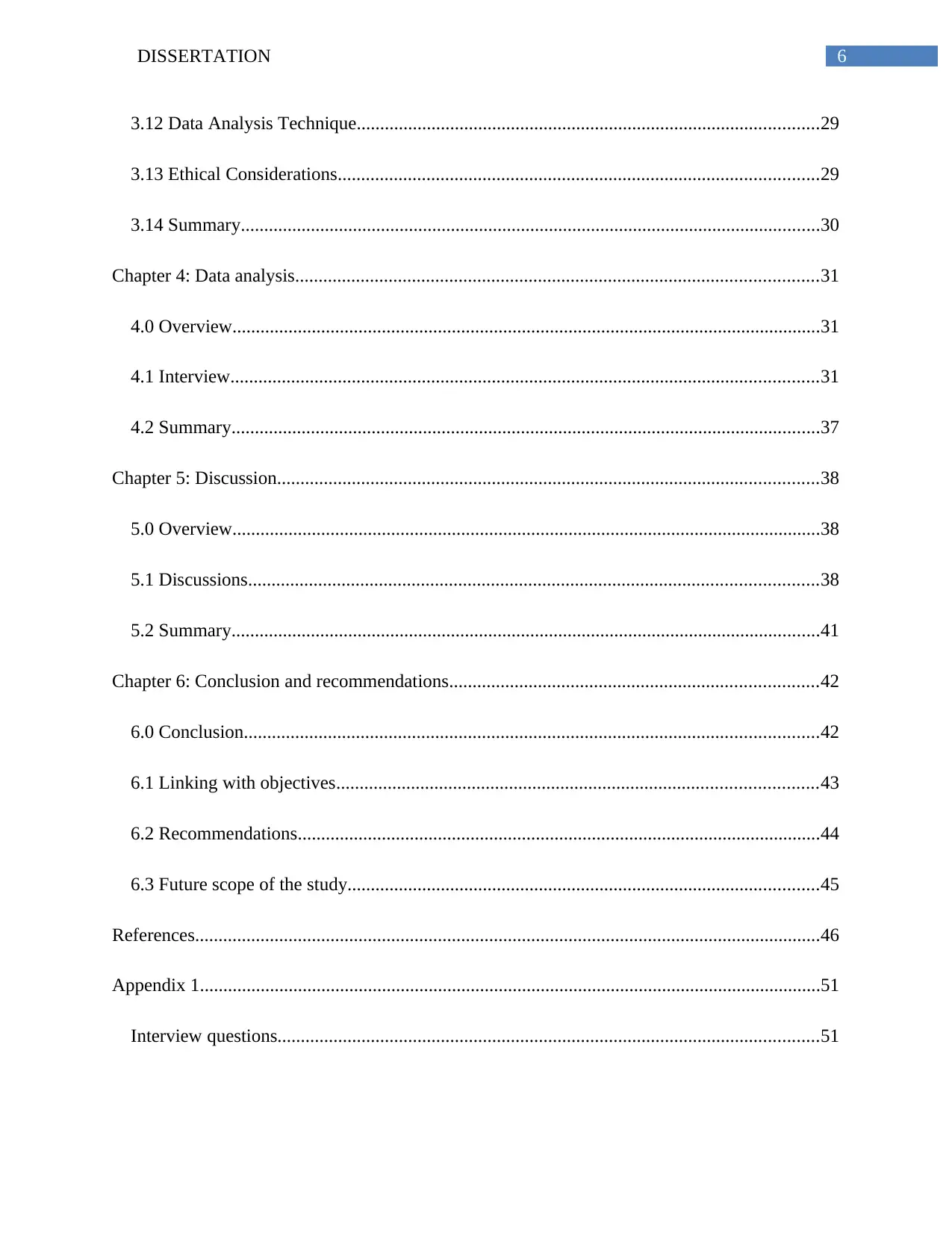
6DISSERTATION
3.12 Data Analysis Technique...................................................................................................29
3.13 Ethical Considerations.......................................................................................................29
3.14 Summary............................................................................................................................30
Chapter 4: Data analysis................................................................................................................31
4.0 Overview..............................................................................................................................31
4.1 Interview..............................................................................................................................31
4.2 Summary..............................................................................................................................37
Chapter 5: Discussion....................................................................................................................38
5.0 Overview..............................................................................................................................38
5.1 Discussions..........................................................................................................................38
5.2 Summary..............................................................................................................................41
Chapter 6: Conclusion and recommendations...............................................................................42
6.0 Conclusion...........................................................................................................................42
6.1 Linking with objectives.......................................................................................................43
6.2 Recommendations................................................................................................................44
6.3 Future scope of the study.....................................................................................................45
References......................................................................................................................................46
Appendix 1.....................................................................................................................................51
Interview questions....................................................................................................................51
3.12 Data Analysis Technique...................................................................................................29
3.13 Ethical Considerations.......................................................................................................29
3.14 Summary............................................................................................................................30
Chapter 4: Data analysis................................................................................................................31
4.0 Overview..............................................................................................................................31
4.1 Interview..............................................................................................................................31
4.2 Summary..............................................................................................................................37
Chapter 5: Discussion....................................................................................................................38
5.0 Overview..............................................................................................................................38
5.1 Discussions..........................................................................................................................38
5.2 Summary..............................................................................................................................41
Chapter 6: Conclusion and recommendations...............................................................................42
6.0 Conclusion...........................................................................................................................42
6.1 Linking with objectives.......................................................................................................43
6.2 Recommendations................................................................................................................44
6.3 Future scope of the study.....................................................................................................45
References......................................................................................................................................46
Appendix 1.....................................................................................................................................51
Interview questions....................................................................................................................51
Paraphrase This Document
Need a fresh take? Get an instant paraphrase of this document with our AI Paraphraser
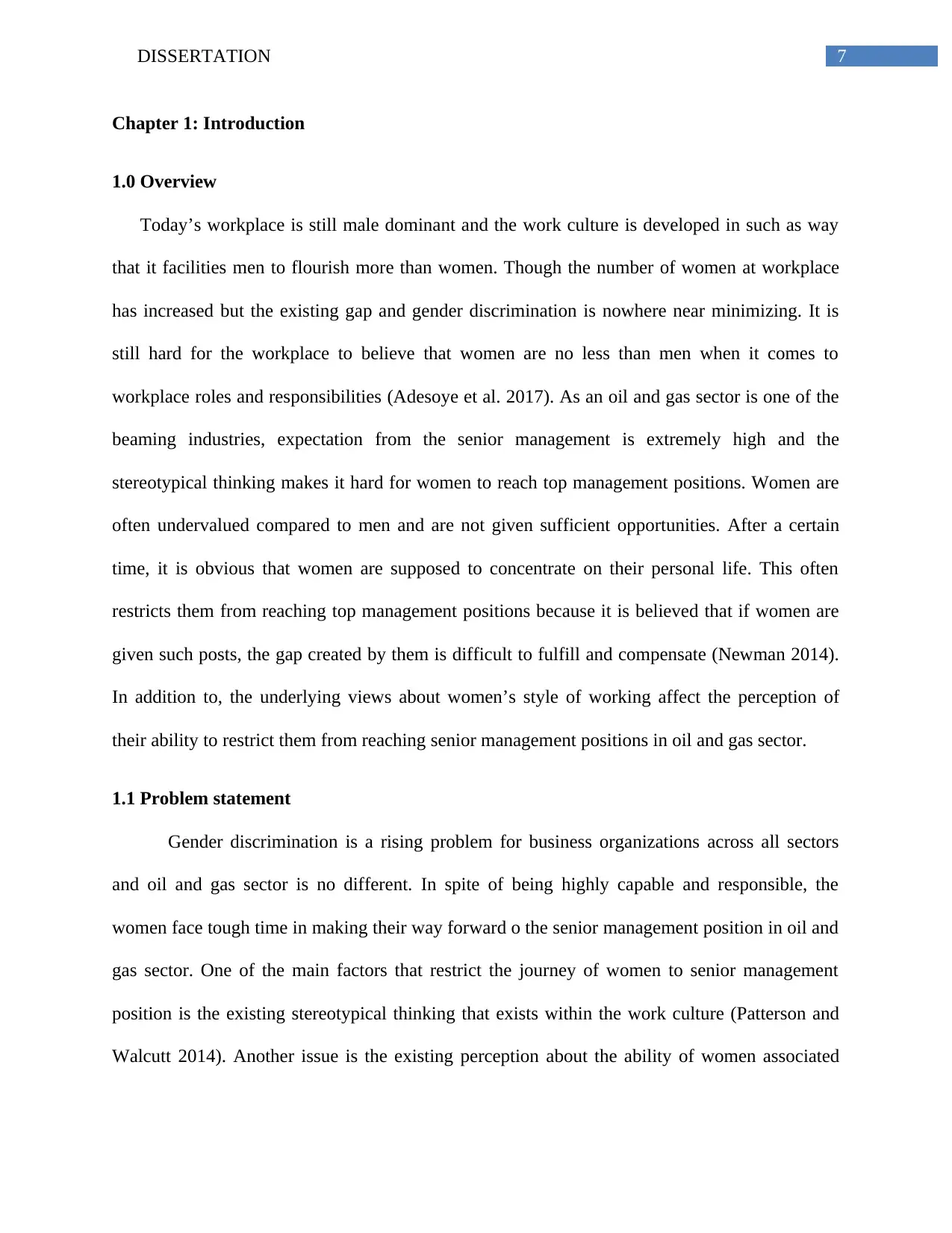
7DISSERTATION
Chapter 1: Introduction
1.0 Overview
Today’s workplace is still male dominant and the work culture is developed in such as way
that it facilities men to flourish more than women. Though the number of women at workplace
has increased but the existing gap and gender discrimination is nowhere near minimizing. It is
still hard for the workplace to believe that women are no less than men when it comes to
workplace roles and responsibilities (Adesoye et al. 2017). As an oil and gas sector is one of the
beaming industries, expectation from the senior management is extremely high and the
stereotypical thinking makes it hard for women to reach top management positions. Women are
often undervalued compared to men and are not given sufficient opportunities. After a certain
time, it is obvious that women are supposed to concentrate on their personal life. This often
restricts them from reaching top management positions because it is believed that if women are
given such posts, the gap created by them is difficult to fulfill and compensate (Newman 2014).
In addition to, the underlying views about women’s style of working affect the perception of
their ability to restrict them from reaching senior management positions in oil and gas sector.
1.1 Problem statement
Gender discrimination is a rising problem for business organizations across all sectors
and oil and gas sector is no different. In spite of being highly capable and responsible, the
women face tough time in making their way forward o the senior management position in oil and
gas sector. One of the main factors that restrict the journey of women to senior management
position is the existing stereotypical thinking that exists within the work culture (Patterson and
Walcutt 2014). Another issue is the existing perception about the ability of women associated
Chapter 1: Introduction
1.0 Overview
Today’s workplace is still male dominant and the work culture is developed in such as way
that it facilities men to flourish more than women. Though the number of women at workplace
has increased but the existing gap and gender discrimination is nowhere near minimizing. It is
still hard for the workplace to believe that women are no less than men when it comes to
workplace roles and responsibilities (Adesoye et al. 2017). As an oil and gas sector is one of the
beaming industries, expectation from the senior management is extremely high and the
stereotypical thinking makes it hard for women to reach top management positions. Women are
often undervalued compared to men and are not given sufficient opportunities. After a certain
time, it is obvious that women are supposed to concentrate on their personal life. This often
restricts them from reaching top management positions because it is believed that if women are
given such posts, the gap created by them is difficult to fulfill and compensate (Newman 2014).
In addition to, the underlying views about women’s style of working affect the perception of
their ability to restrict them from reaching senior management positions in oil and gas sector.
1.1 Problem statement
Gender discrimination is a rising problem for business organizations across all sectors
and oil and gas sector is no different. In spite of being highly capable and responsible, the
women face tough time in making their way forward o the senior management position in oil and
gas sector. One of the main factors that restrict the journey of women to senior management
position is the existing stereotypical thinking that exists within the work culture (Patterson and
Walcutt 2014). Another issue is the existing perception about the ability of women associated
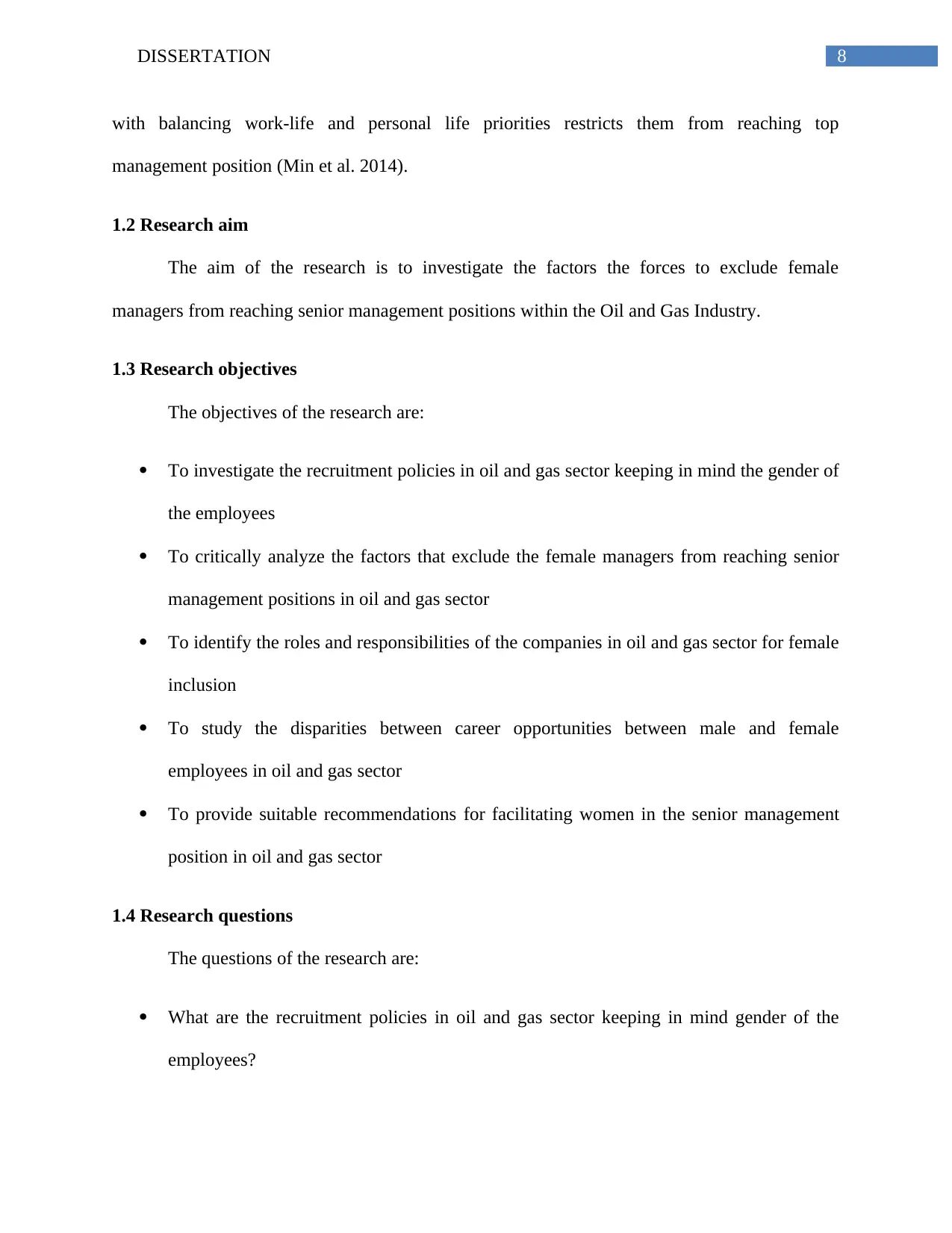
8DISSERTATION
with balancing work-life and personal life priorities restricts them from reaching top
management position (Min et al. 2014).
1.2 Research aim
The aim of the research is to investigate the factors the forces to exclude female
managers from reaching senior management positions within the Oil and Gas Industry.
1.3 Research objectives
The objectives of the research are:
To investigate the recruitment policies in oil and gas sector keeping in mind the gender of
the employees
To critically analyze the factors that exclude the female managers from reaching senior
management positions in oil and gas sector
To identify the roles and responsibilities of the companies in oil and gas sector for female
inclusion
To study the disparities between career opportunities between male and female
employees in oil and gas sector
To provide suitable recommendations for facilitating women in the senior management
position in oil and gas sector
1.4 Research questions
The questions of the research are:
What are the recruitment policies in oil and gas sector keeping in mind gender of the
employees?
with balancing work-life and personal life priorities restricts them from reaching top
management position (Min et al. 2014).
1.2 Research aim
The aim of the research is to investigate the factors the forces to exclude female
managers from reaching senior management positions within the Oil and Gas Industry.
1.3 Research objectives
The objectives of the research are:
To investigate the recruitment policies in oil and gas sector keeping in mind the gender of
the employees
To critically analyze the factors that exclude the female managers from reaching senior
management positions in oil and gas sector
To identify the roles and responsibilities of the companies in oil and gas sector for female
inclusion
To study the disparities between career opportunities between male and female
employees in oil and gas sector
To provide suitable recommendations for facilitating women in the senior management
position in oil and gas sector
1.4 Research questions
The questions of the research are:
What are the recruitment policies in oil and gas sector keeping in mind gender of the
employees?
⊘ This is a preview!⊘
Do you want full access?
Subscribe today to unlock all pages.

Trusted by 1+ million students worldwide
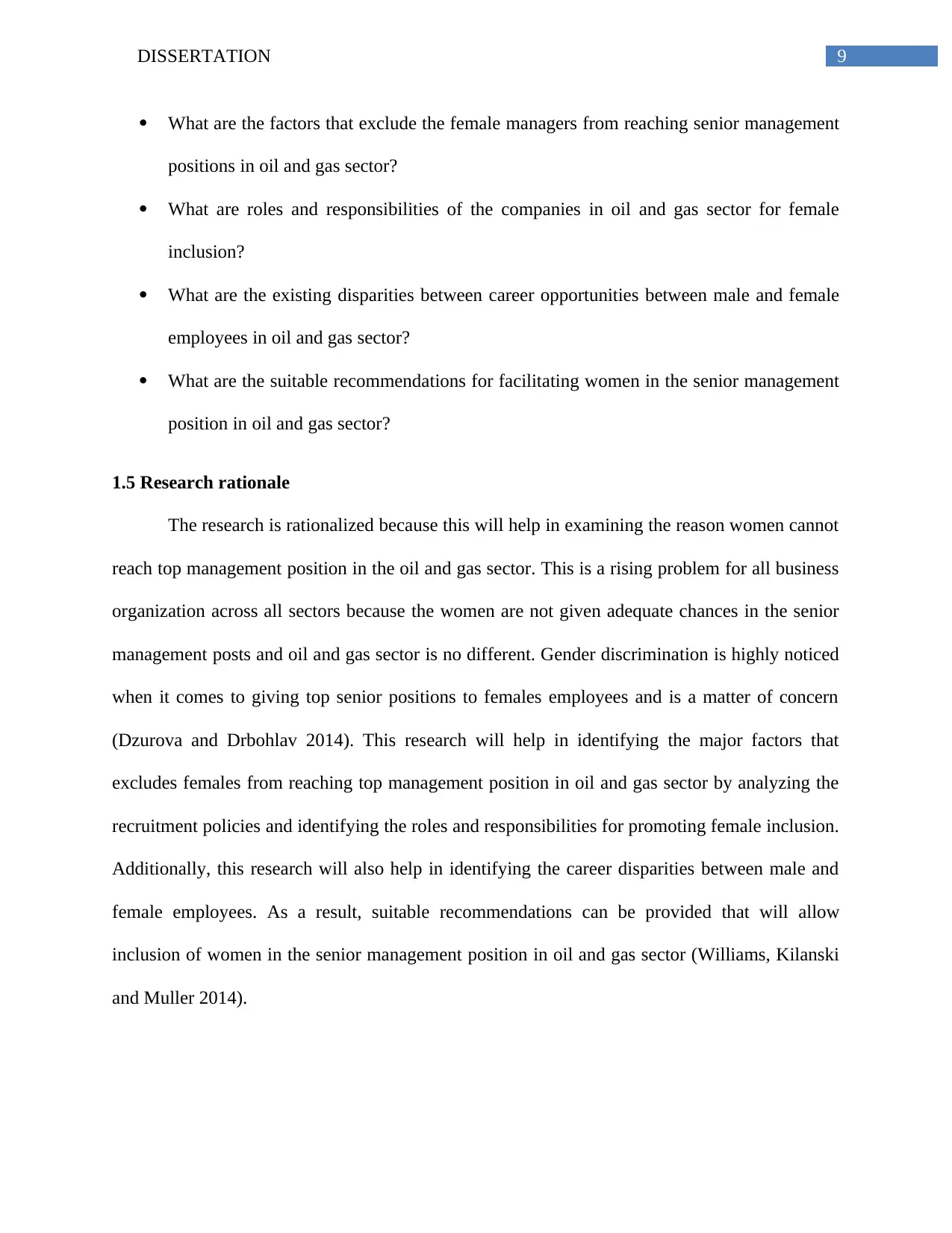
9DISSERTATION
What are the factors that exclude the female managers from reaching senior management
positions in oil and gas sector?
What are roles and responsibilities of the companies in oil and gas sector for female
inclusion?
What are the existing disparities between career opportunities between male and female
employees in oil and gas sector?
What are the suitable recommendations for facilitating women in the senior management
position in oil and gas sector?
1.5 Research rationale
The research is rationalized because this will help in examining the reason women cannot
reach top management position in the oil and gas sector. This is a rising problem for all business
organization across all sectors because the women are not given adequate chances in the senior
management posts and oil and gas sector is no different. Gender discrimination is highly noticed
when it comes to giving top senior positions to females employees and is a matter of concern
(Dzurova and Drbohlav 2014). This research will help in identifying the major factors that
excludes females from reaching top management position in oil and gas sector by analyzing the
recruitment policies and identifying the roles and responsibilities for promoting female inclusion.
Additionally, this research will also help in identifying the career disparities between male and
female employees. As a result, suitable recommendations can be provided that will allow
inclusion of women in the senior management position in oil and gas sector (Williams, Kilanski
and Muller 2014).
What are the factors that exclude the female managers from reaching senior management
positions in oil and gas sector?
What are roles and responsibilities of the companies in oil and gas sector for female
inclusion?
What are the existing disparities between career opportunities between male and female
employees in oil and gas sector?
What are the suitable recommendations for facilitating women in the senior management
position in oil and gas sector?
1.5 Research rationale
The research is rationalized because this will help in examining the reason women cannot
reach top management position in the oil and gas sector. This is a rising problem for all business
organization across all sectors because the women are not given adequate chances in the senior
management posts and oil and gas sector is no different. Gender discrimination is highly noticed
when it comes to giving top senior positions to females employees and is a matter of concern
(Dzurova and Drbohlav 2014). This research will help in identifying the major factors that
excludes females from reaching top management position in oil and gas sector by analyzing the
recruitment policies and identifying the roles and responsibilities for promoting female inclusion.
Additionally, this research will also help in identifying the career disparities between male and
female employees. As a result, suitable recommendations can be provided that will allow
inclusion of women in the senior management position in oil and gas sector (Williams, Kilanski
and Muller 2014).
Paraphrase This Document
Need a fresh take? Get an instant paraphrase of this document with our AI Paraphraser
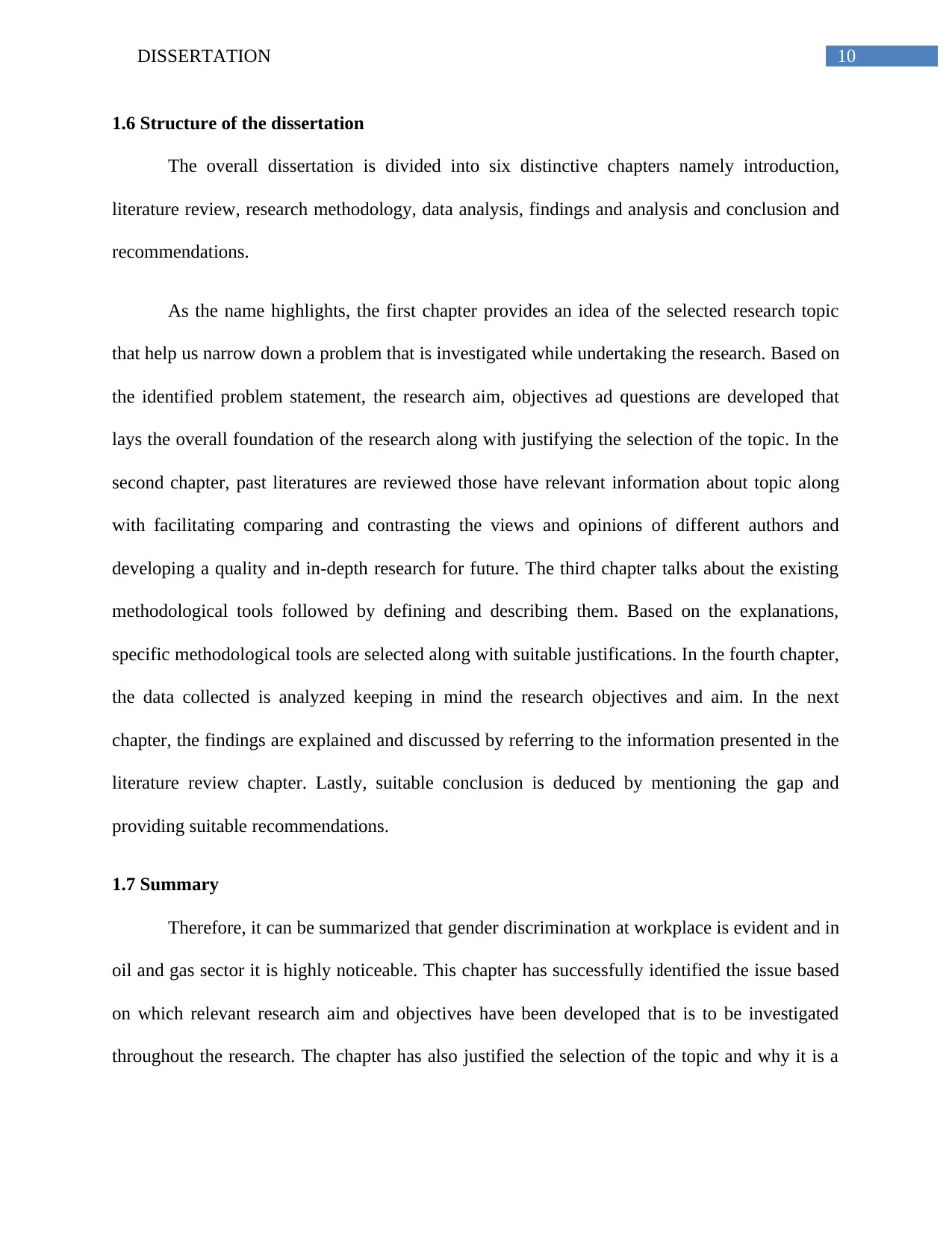
10DISSERTATION
1.6 Structure of the dissertation
The overall dissertation is divided into six distinctive chapters namely introduction,
literature review, research methodology, data analysis, findings and analysis and conclusion and
recommendations.
As the name highlights, the first chapter provides an idea of the selected research topic
that help us narrow down a problem that is investigated while undertaking the research. Based on
the identified problem statement, the research aim, objectives ad questions are developed that
lays the overall foundation of the research along with justifying the selection of the topic. In the
second chapter, past literatures are reviewed those have relevant information about topic along
with facilitating comparing and contrasting the views and opinions of different authors and
developing a quality and in-depth research for future. The third chapter talks about the existing
methodological tools followed by defining and describing them. Based on the explanations,
specific methodological tools are selected along with suitable justifications. In the fourth chapter,
the data collected is analyzed keeping in mind the research objectives and aim. In the next
chapter, the findings are explained and discussed by referring to the information presented in the
literature review chapter. Lastly, suitable conclusion is deduced by mentioning the gap and
providing suitable recommendations.
1.7 Summary
Therefore, it can be summarized that gender discrimination at workplace is evident and in
oil and gas sector it is highly noticeable. This chapter has successfully identified the issue based
on which relevant research aim and objectives have been developed that is to be investigated
throughout the research. The chapter has also justified the selection of the topic and why it is a
1.6 Structure of the dissertation
The overall dissertation is divided into six distinctive chapters namely introduction,
literature review, research methodology, data analysis, findings and analysis and conclusion and
recommendations.
As the name highlights, the first chapter provides an idea of the selected research topic
that help us narrow down a problem that is investigated while undertaking the research. Based on
the identified problem statement, the research aim, objectives ad questions are developed that
lays the overall foundation of the research along with justifying the selection of the topic. In the
second chapter, past literatures are reviewed those have relevant information about topic along
with facilitating comparing and contrasting the views and opinions of different authors and
developing a quality and in-depth research for future. The third chapter talks about the existing
methodological tools followed by defining and describing them. Based on the explanations,
specific methodological tools are selected along with suitable justifications. In the fourth chapter,
the data collected is analyzed keeping in mind the research objectives and aim. In the next
chapter, the findings are explained and discussed by referring to the information presented in the
literature review chapter. Lastly, suitable conclusion is deduced by mentioning the gap and
providing suitable recommendations.
1.7 Summary
Therefore, it can be summarized that gender discrimination at workplace is evident and in
oil and gas sector it is highly noticeable. This chapter has successfully identified the issue based
on which relevant research aim and objectives have been developed that is to be investigated
throughout the research. The chapter has also justified the selection of the topic and why it is a
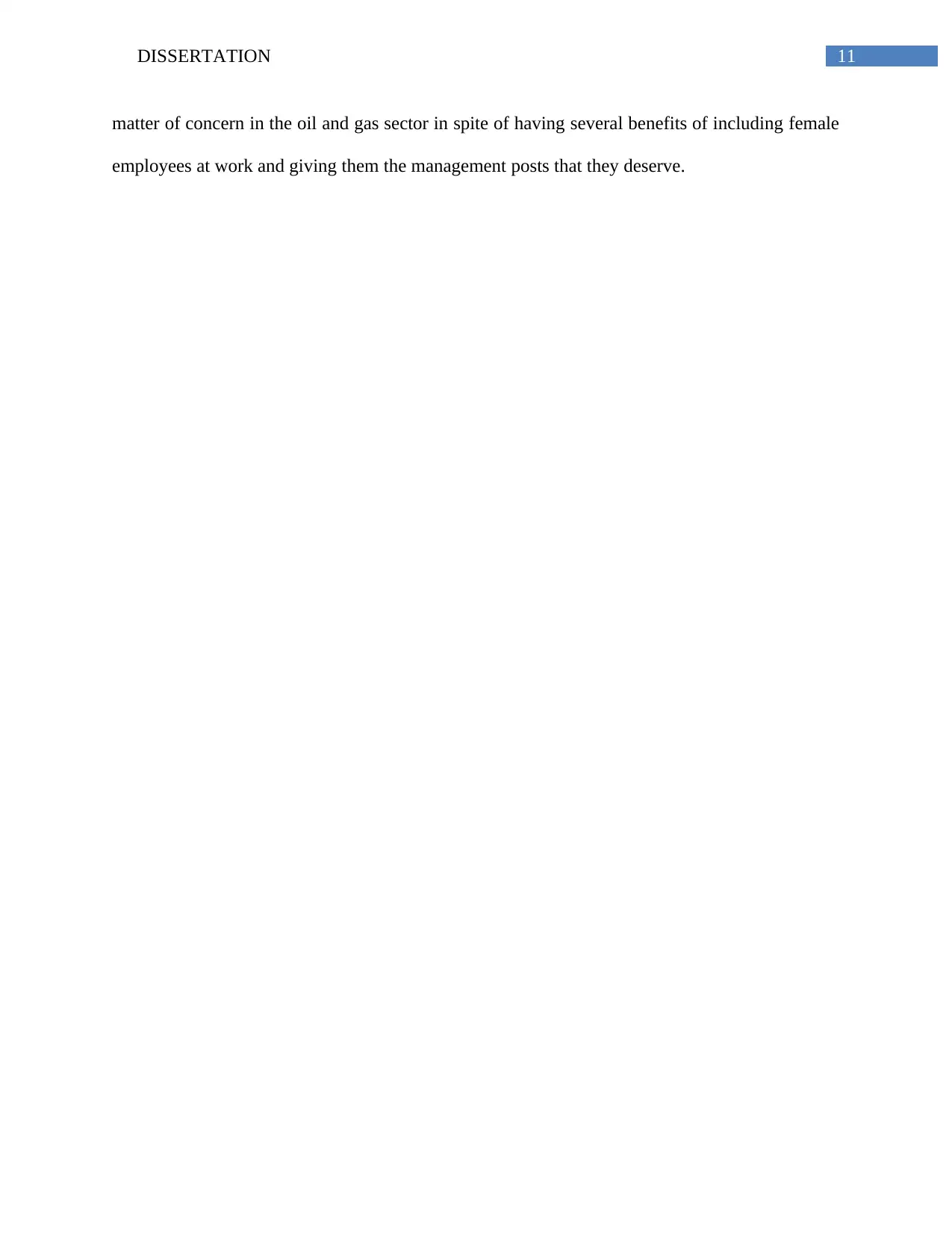
11DISSERTATION
matter of concern in the oil and gas sector in spite of having several benefits of including female
employees at work and giving them the management posts that they deserve.
matter of concern in the oil and gas sector in spite of having several benefits of including female
employees at work and giving them the management posts that they deserve.
⊘ This is a preview!⊘
Do you want full access?
Subscribe today to unlock all pages.

Trusted by 1+ million students worldwide
1 out of 52
Related Documents
Your All-in-One AI-Powered Toolkit for Academic Success.
+13062052269
info@desklib.com
Available 24*7 on WhatsApp / Email
![[object Object]](/_next/static/media/star-bottom.7253800d.svg)
Unlock your academic potential
Copyright © 2020–2025 A2Z Services. All Rights Reserved. Developed and managed by ZUCOL.





